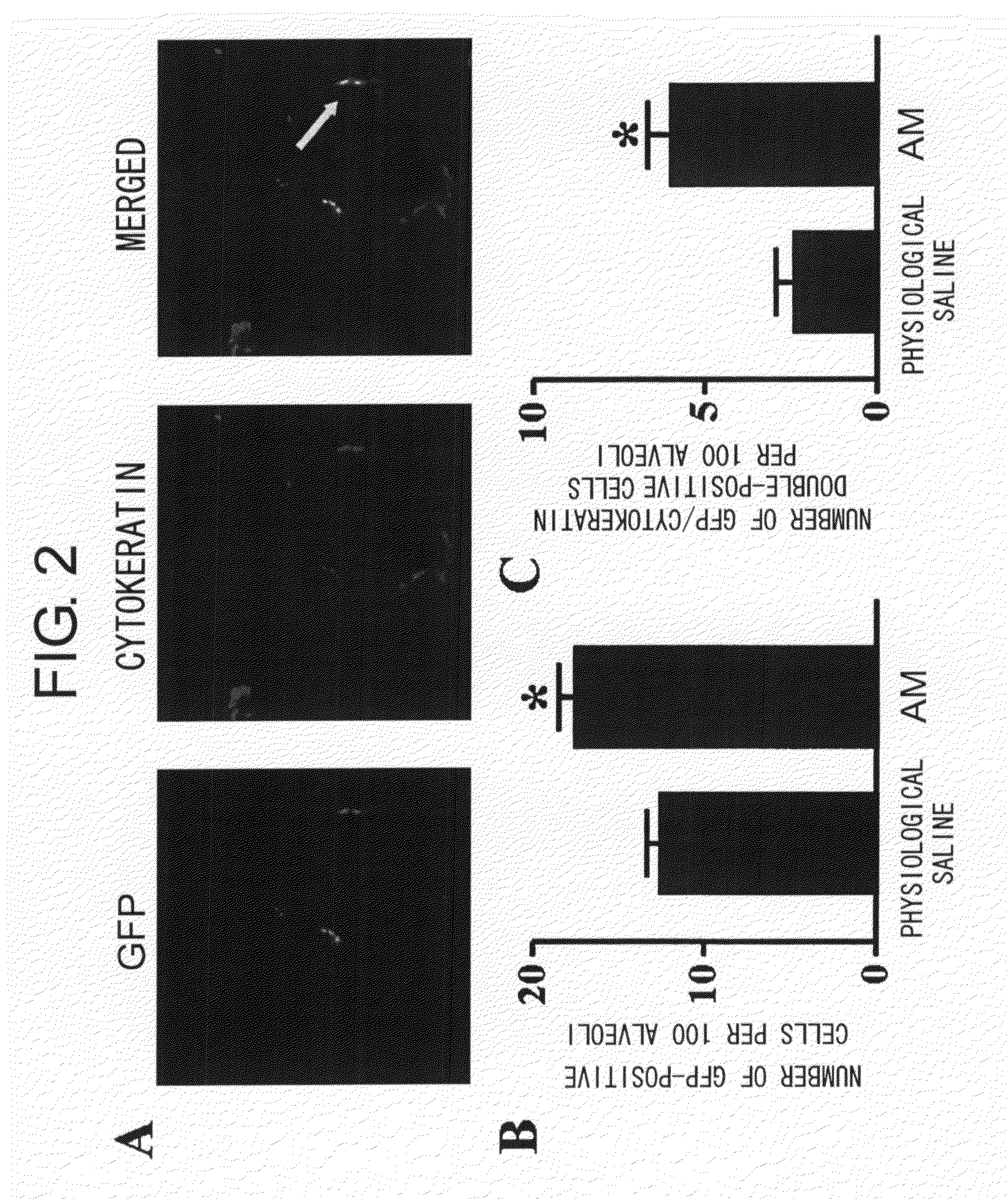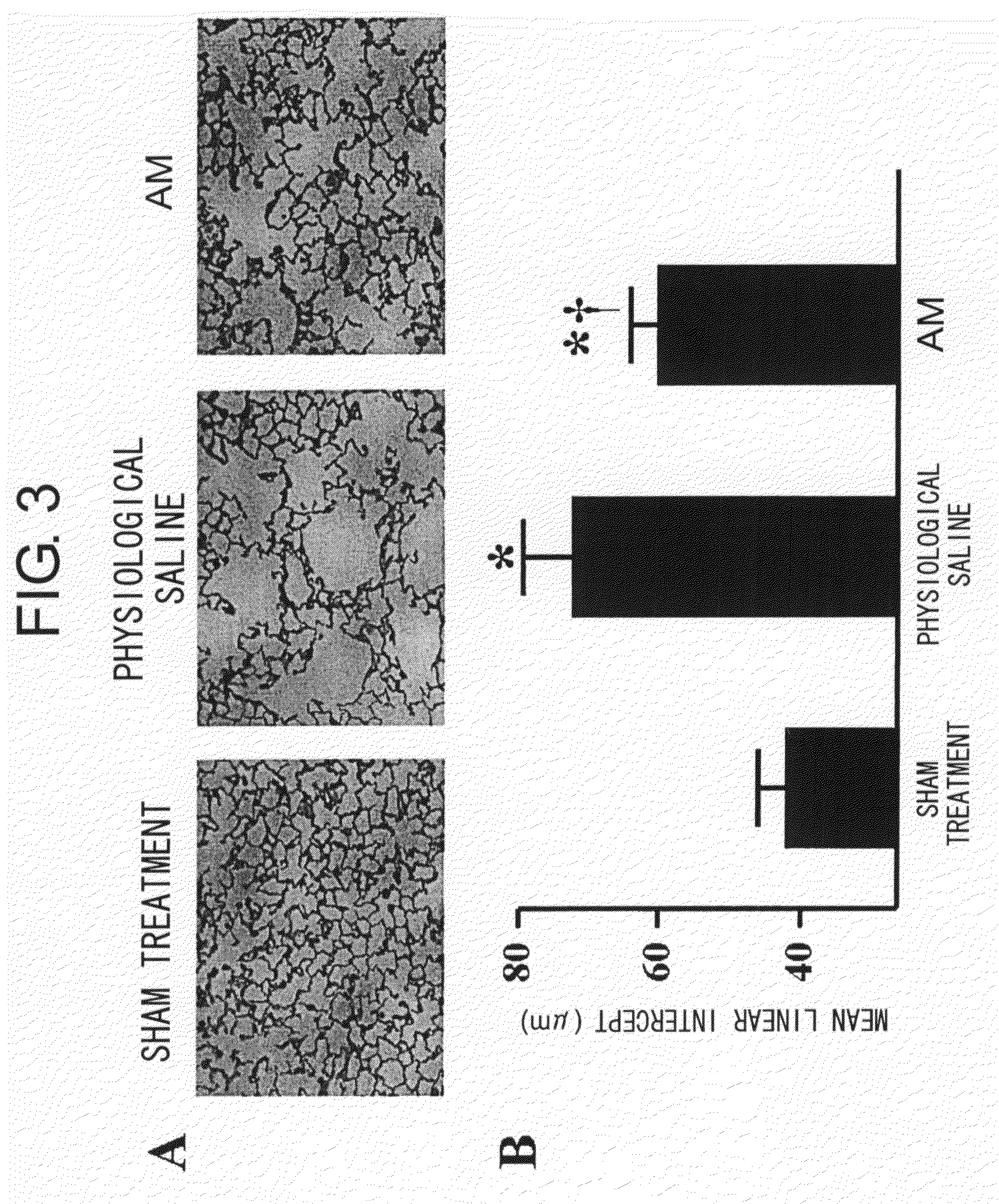Methods for Regenerating and Repairing Damaged Tissues Using Adrenomedullin
- Summary
- Abstract
- Description
- Claims
- Application Information
AI Technical Summary
Benefits of technology
Problems solved by technology
Method used
Image
Examples
example 1
Evaluation and Measurement of the Dynamics of Bone Marrow Cells by Administration of Adrenomedullin
[0096]First, to investigate whether AM has an effect on the dynamics of bone marrow cells, AM or physiological saline was administered randomly to model animals. As the model animals, 48 ten-week old female C57BL / 6 mice were used. The transgenic mice (C57BL / 6 background) which ubiquitously express green fluorescence protein (GFP) were kindly offered by Professor Masaru Okabe (Osaka University, Japan) (Okabe M, Ikawa M, Kominami K, Nakanishi T, Nishimune Y. ‘Green mice’ as a source of ubiquitous green cells. FEBS Lett 1997; 407: 313-319).
[0097]AM (1 μg, 2 μg, or 5 μg in 100 μl physiological saline) was randomly administrated to the C57BL / 6 mice (each, n=8) by intraperitoneal injection every day for five days. The control mice were similarly administered with 100 μl physiological saline every day for five days (n=8).
[0098]Furthermore, AM or physiological saline was administered to other ...
example 2
Evaluation of the Homing and Differentiation of Bone Marrow Cells
[0103]C57BL / 6GFP-positive bone marrow chimeric mice were established for evaluating the dynamics of bone marrow cells.
[0104]The above-mentioned bone marrow chimeric mice were produced by a method known to those skilled in the art (Sata M, Saiura A, Kunisato A, Tojo A, Okada S, Tokuhisa T, Hirai H, Makuuchi M, Hirata Y, Nagai R. Hematopoietic stem cells differentiate into vascular cells that participate in the pathogenesis of atherosclerosis. Nat Med 2002; 8: 403-409). To put it briefly, a lethal dose of radiation (900 cGy) was applied to wild-type recipient C57BL / 6 mice, and bone marrow cells (3×106 cells / 300 μl) derived from the GFP mouse were transplanted through the tail vein. In order to quantify the reconstitution of mouse bone marrow, mononuclear cells and bone marrow cells in the peripheral blood were analyzed by flow cytometry four weeks after the bone marrow transplant. The percentages of the GFP-positive peri...
example 3
Morphological and Functional Analyses of Elastase-Treated Mice Administered with AM
[0110]It has been sufficiently demonstrated so far that pulmonary emphysema is induced by intratracheal injection of protease such as elastase to experimental animals (Snider G L, Lucey E C, Stone P J. Animal models of emphysema. Am Rev Respir Dis 1986; 133: 149-169). In fact, in the present invention, findings about lung functions (increase in lung volume and static lung compliance) and morphological findings (increase in the average alveolar diameter) confirmed that emphysematous changes were induced in the lungs by intratracheal injection of elastase, and these findings are consistent with the results from previous studies (Hayes J A, Korthy A, Snider G L. The pathology of elastase-induced panacinar emphysema in hamsters. J Pathol 1975; 117: 1-14; Kuraki T, Ishibashi M, Takayama M, Shiraishi M, Yoshida M. A novel oral neutrophil elastase inhibitor (ONO-6818) inhibits human neutrophil elastase-induc...
PUM
| Property | Measurement | Unit |
|---|---|---|
| Diameter | aaaaa | aaaaa |
| Size | aaaaa | aaaaa |
Abstract
Description
Claims
Application Information
 Login to View More
Login to View More - R&D
- Intellectual Property
- Life Sciences
- Materials
- Tech Scout
- Unparalleled Data Quality
- Higher Quality Content
- 60% Fewer Hallucinations
Browse by: Latest US Patents, China's latest patents, Technical Efficacy Thesaurus, Application Domain, Technology Topic, Popular Technical Reports.
© 2025 PatSnap. All rights reserved.Legal|Privacy policy|Modern Slavery Act Transparency Statement|Sitemap|About US| Contact US: help@patsnap.com



